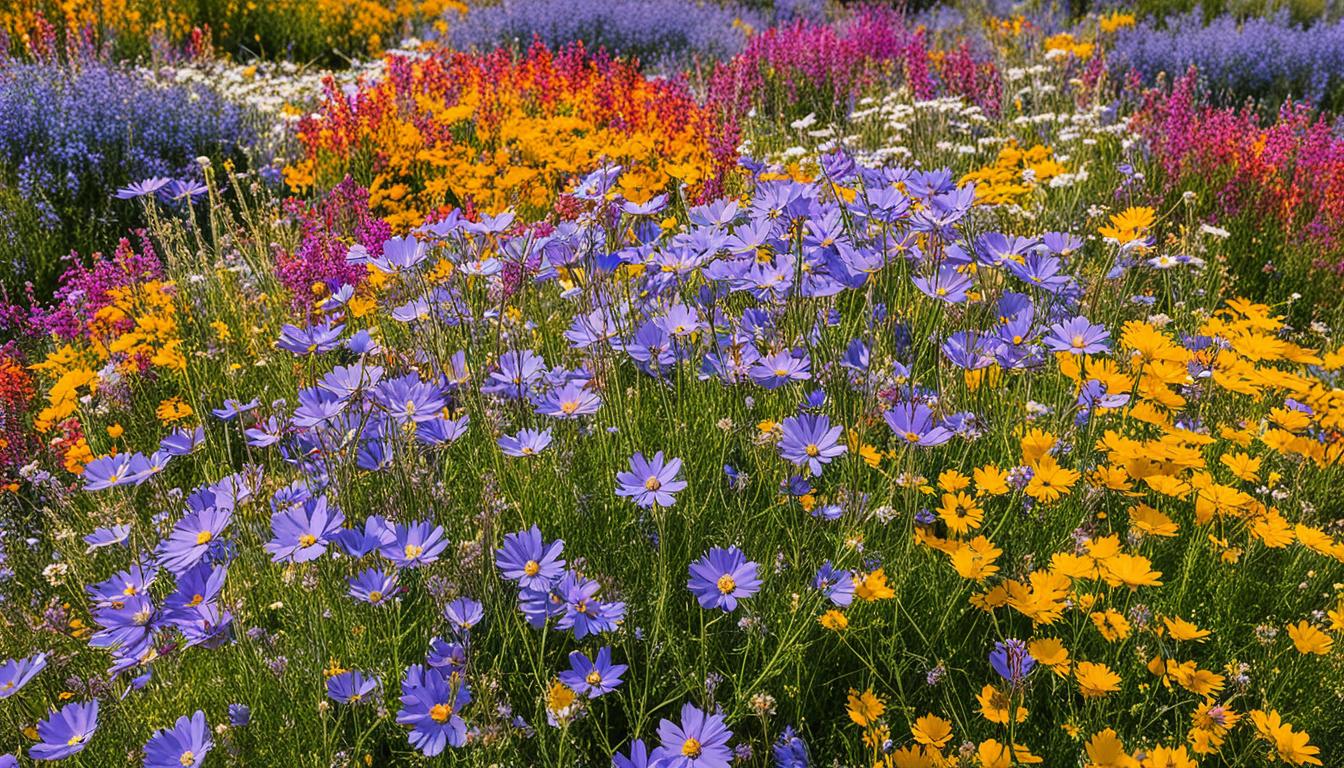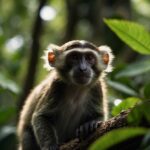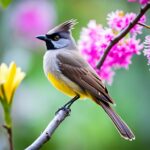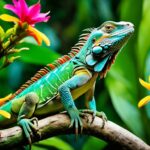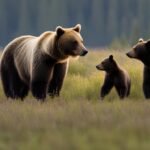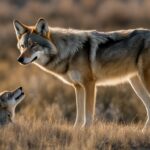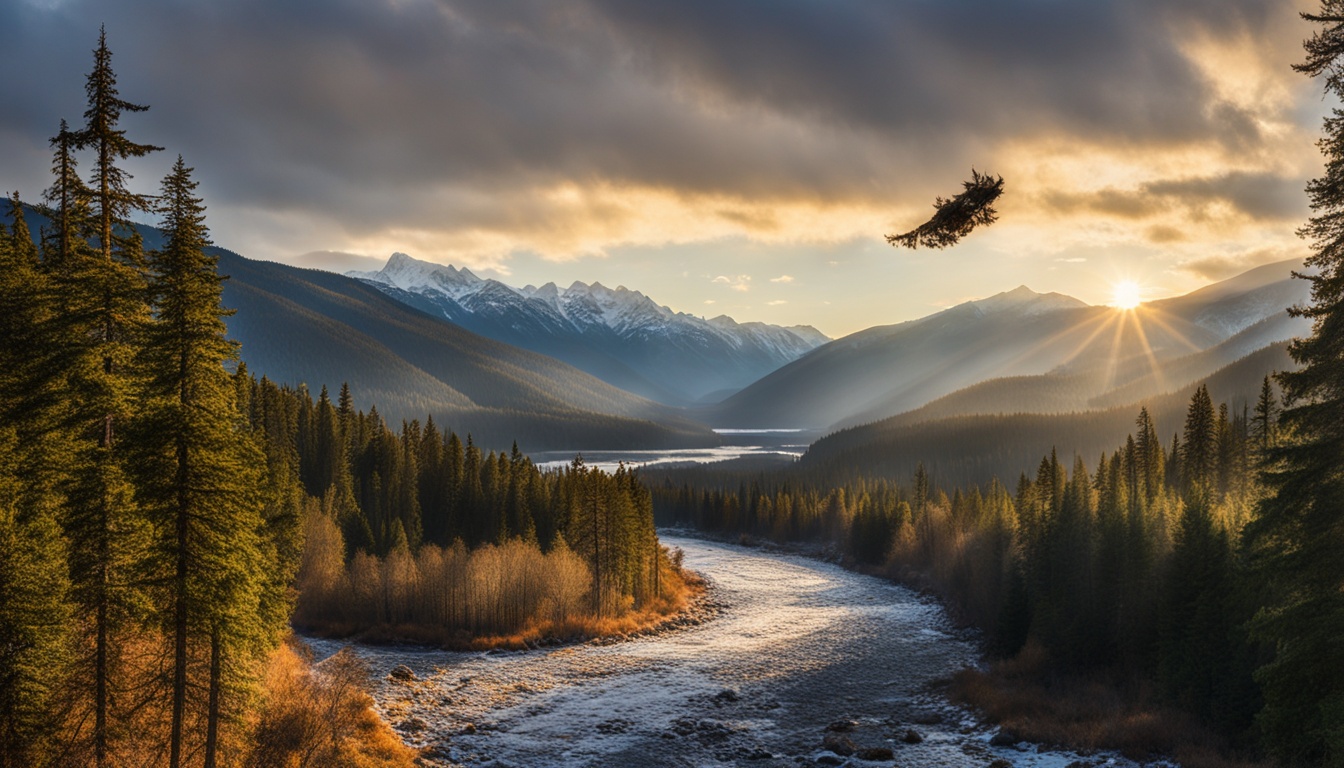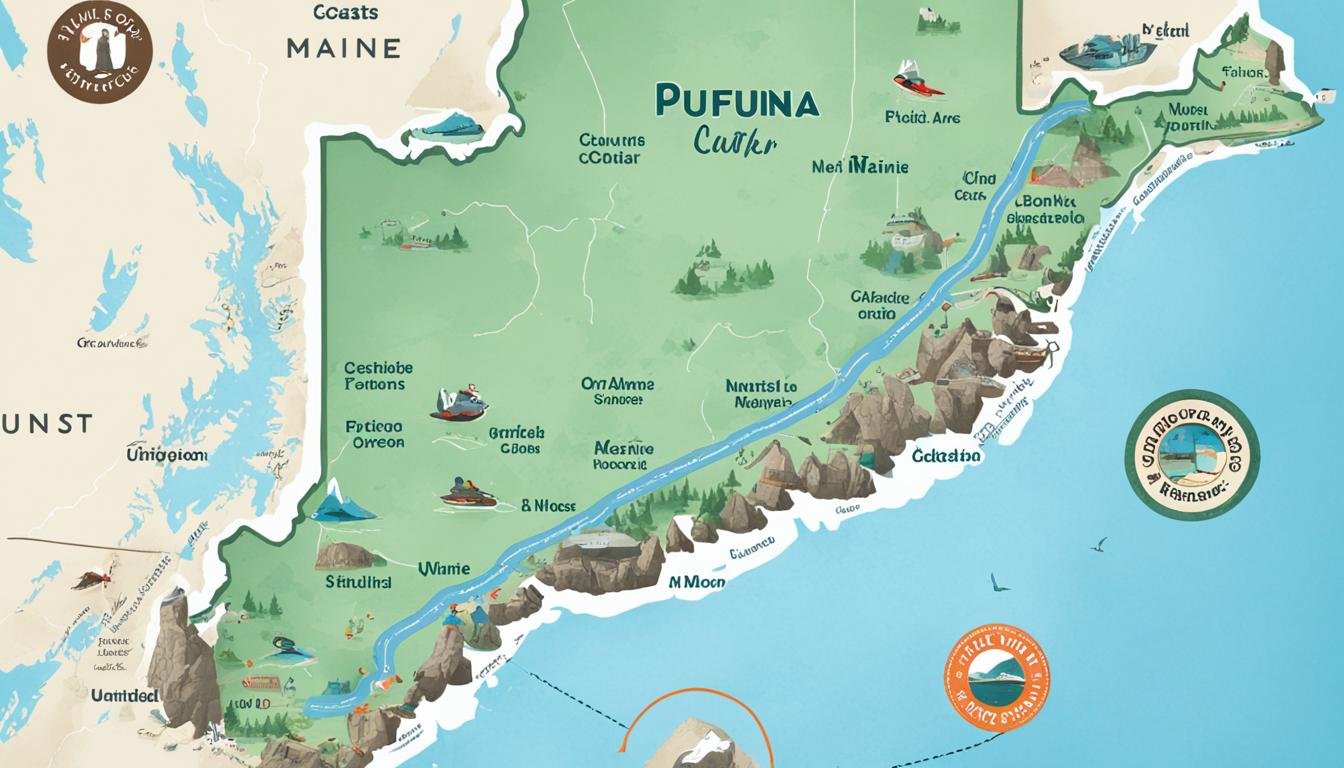Native wildflowers are crucial for attracting bees in the USA. They are vital for conserving bees, but they aren’t the whole solution. Bees come from a background of living in trees, so they mainly feed on trees and bushes.
When adding wildflowers to your garden, you must manage them well. This means keeping them from taking over. This way, smaller but essential plants can also grow.
The key to helping bee populations is planting the right wildflowers. Choose plants that bloom all year in grassy areas. Your bee garden will be healthy with favorites like Bird’s Foot Trefoil and Daisies.
Starting with good intentions is not enough. To make a place where bees can truly thrive, you must plant wisely. Pick wildflowers that bloom at different times. This ensures bees find food in your garden throughout the year.
The Importance of Wildflowers for Bees
Wildflowers are super important for bee life. They offer sweet nectar that bees need to survive. These bee-friendly flowers in America also give them a place to live.
Wildflower meadows bloom from early spring to late fall. This means bees always have food. These meadows are more than food; they’re homes for bees and other helpful animals.
Using non-GMO and neonicotinoid-free seeds is key. This helps plants support a healthy environment. It also keeps bee populations strong.
Planting a mix of bee-friendly wildflowers helps bees a lot. These flowers aren’t just pretty, they’re essential. They keep our world in balance, supporting a variety of life.
Top Native Bee-Friendly Flowers
Creating a garden that’s friendly to bees is key. Adding flowers that attract bees can make a big difference. Here are several native flowers that bees love.
Bird’s Foot Trefoil
Bird’s Foot Trefoil is often seen in wildflower mixes. Bees love its yellow flowers for their rich pollen and nectar. It stands out in meadows, drawing honeybees.
Wild Blackberry
Wild Blackberries are important for bees in late spring and early summer. They have blooms that turn into berries, benefiting many wildlife species. So, they’re great for both you and your local ecosystem.
Daisies
Daisies come in all sizes, from small lawn types to large Ox-Eye ones. They’re a solid choice for bees because they offer plenty of nectar. Their pretty, simple flowers are exactly what pollinators like.
Dandelion
Dandelions are among the first flowers that bees visit in spring. They offer life-saving food (pollen and nectar) when other plants aren’t yet blooming. So, early bees depend on them.
Dog Rose
Dog Rose is a wild climbing rose that blooms all summer. It’s a feast for bees with its pink flowers. Plus, its rose hips in the fall feed many animals.
These flowers not only beautify your garden but also help bees. By planting them, you’re making a home where bees can thrive. This helps bees stay healthy and strong.
Creating a Bee-friendly Wildflower Meadow
Creating a bee-friendly wildflower meadow in the United States takes a few key steps. Doing this right can make a home for bees that lasts.
Choosing the Right Soil
Starting with the right soil helps different wildflowers grow well. The soil should fit what bee-attracting plants need. Testing the soil can show you what pH and nutrient levels are necessary for wildflowers. This test helps the plants thrive.
Managing Invasive Species
Invasive species can be a big problem, taking over from the native plants that attract bees. Keep an eye out and use methods like hand-pulling or the right herbicides to keep things in check.
Seasonal Maintenance
Keeping up with the meadow through the seasons is crucial for the bee plants to do well. This work could be things like mowing at the right times to help the small, good plants grow.
| Maintenance Task | Spring | Summer | Fall | Winter |
|---|---|---|---|---|
| Soil Preparation and Testing | Start | Monitor | Amend | Rest |
| Weed Management | High | Moderate | Moderate | Low |
| Controlled Mowing/Grazing | Low | High | Low | None |
Best Wildflowers to Attract Bees in Your Garden
Bees love wildflowers with bright colors, sweet scents, and easy-to-reach nectar. Including these kinds of flowers in your garden will draw in more bees. This makes your garden a great place for these important pollinators.
Wildflowers that have tubular or flat blooms are a hit with bees. They allow for easy access to nectar and comfortable landings for these buzzing friends. Here are some top wildflowers bees adore:
- Foxglove – Known for its tubular blossoms.
- Teasel – With its dome of tiny flowers, it becomes a bee magnet.
- Daisies – Flat-petaled and vibrant, ideal for resting and feeding.
- Bluebells – Offering shelter and nectar within their bell-shaped blooms.
Planting a mix of these wildflowers makes your garden a bee paradise. Bees get the food and shelter they need. And, it makes your garden more diverse and beautiful too.
Why Wildflower Diversity Matters for Bee Populations
Attracting bees with native wildflowers is key to keeping bee colonies healthy. It’s crucial to have different kinds of wildflowers. This provides bees with a varied and nutritious diet, helping them stay strong.
A mix of wildflowers keeps bees fed from spring to fall. This steady food source is vital for their survival. Using native wildflowers also protects the environment by supporting plant and animal diversity, which is good for bees.
Here’s how different seasons and varieties of flowers help bees:
| Season | Wildflower Varieties | Benefits for Bees |
|---|---|---|
| Early Spring | Dandelions, Bird’s Foot Trefoil | First sources of nectar and pollen after winter |
| Late Spring to Early Summer | Wild Blackberries, Daisies | Provide consistent nectar flow and support early colony growth |
| Summer to Fall | Dog Rose, Oxeye Daisy | Sustains colonies with continuous food supply up to fall |
Adding a mixture of flowers to your garden or meadow really helps bee conservation. It ensures bees have plenty of food all year. This action creates a place where bees can find food anytime they need it.
Regional Wildflower Mixtures for Pollinators
Making wildflower mixes just for pollinators is key to keeping bee numbers high and healthy. Using local wildflowers in bee gardens means these insects always have something to eat. This meets the bees’ needs every season.
Spring Blooms
In spring, wildflowers like California poppy and lupine are the first meal for bees waking from winter. Adding them to our gardens gives bees the nectar and pollen they need. This starts their season of searching for food.
Summer Blooms
When summer comes, flowers like black-eyed Susan and bergamot take over. They offer plenty of food for bees as they work hard during the warmest months. This supports bees’ high-energy requirements.
Fall Blooms
By fall, flowers such as aster and goldenrod bloom. They help bees prepare for winter by stocking up on food. Including these autumn flowers in wildflower mixes aids bees in smoothly moving from season to season. This helps keep them healthy and their numbers up.
Tubular and Bell-like Wildflowers
Tubular and bell-like flowers are great for pollinators. Their shapes make feeding easy and offer protection. This is key for keeping bee populations healthy.
Foxglove
Foxglove is a standout biennial in the wild. It provides many spots for bees to eat. Bees love their tubular wildflowers for bees because they’re full of nectar.
Its tall stems wear bell-like blooms, calling pollinators over.
Teasel
Teasel has a special structure that attracts different pollinators. Its dome of purple petals is a bee magnet. The plant is important for wildlife, feeding birds like Goldfinches with its seeds.
This adds to the area’s biodiversity.
Bluebell
Bluebells are key in woodlands, loved by pollinators. They offer food as well as a calm spot for bees. Here, bees get their food unperturbed, helping them thrive.
Flat-Petaled Wildflowers Bees Love
Bees adore flat-petaled wildflowers because they give a simple spot to land and a lot of nectar. These flowers are very important for providing bees with food and a place to rest.
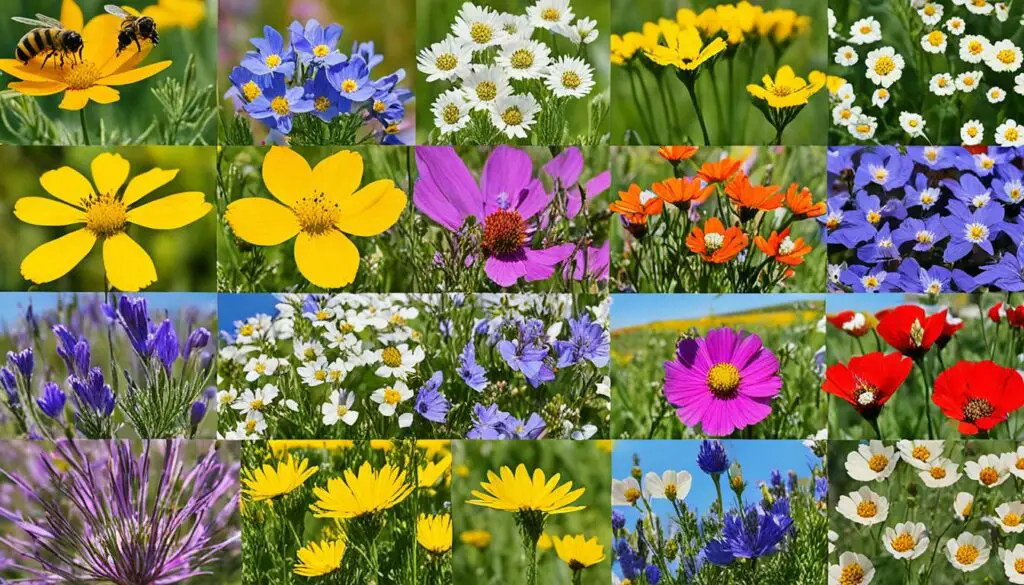
Scabious
Scabious has beautiful lilac flowers that look like pincushions. Bees are drawn to it because it’s easy to land on and has lots of nectar. This makes it a great choice for attracting pollinators.
Oxeye Daisy
The Oxeye Daisy has a bright yellow center that bees love. It acts like a sign, showing there’s plenty of food. The simple design of its flat petals also makes it a convenient place for bees to land.
Knapweed
Knapweed looks a bit like a sea anemone and comes in bright colors. Bees really like it because it’s easy to get to the nectar. Plus, its design makes nectar readily available, which is good for any garden trying to help pollinators.
The Role of Perennial Wildflowers
Perennial wildflowers are essential for a bee-friendly garden. They come back every year, providing a long-lasting food resource for bees. This makes your garden a reliable place for them, as no replanting is needed.
Their regular blooming is key for pollinators, especially bees. Bees know they can find food here at any time. By planting perennials, you help create a steady, sustainable space for insects year-round.
Using perennials means less work planting. It also supports a varied and flourishing landscape. These flowers are a stable food source, attracting bees and other good bugs to your garden.
Understanding the Seasonal Needs of Bees
It’s vital to know what bees need during each season. This knowledge helps create environments where they can live well all year. In spring, bees come out of winter looking for flowers like dandelions. These flowers are crucial because they provide the nectar and pollen bees need for energy and survival.
As spring turns into summer, bees still need lots of flowers. They need a variety of blooms that keep coming. This variety makes sure bees have enough food to stay healthy and productive. Daisies and wild blackberries are especially important during this time.
In fall, keeping a variety of late-blooming flowers is key. It ensures bees have what they need before winter comes. This mix helps bees survive winter and be ready for spring again.
To look after bees, plant wildflowers that bloom at different times. This approach is crucial for bee health and to save them. It provides the nutrition and help they need to keep their colonies strong and thriving.
Combining Trees, Bushes, and Wildflowers
Creating a truly bee-friendly garden goes beyond just wildflowers. It’s about mixing trees, bushes, and wildflowers together. This approach offers bees a variety of plants to feed on. It helps bees stay healthy year-round.
Flowering Trees
Flowering trees are vital for bees, giving them nectar and pollen. Choose trees like American Basswood and the Tulip Tree. They bloom in late spring, a time when wildflowers might not be available. Including these trees in your garden ensures bees always have food.
Flowering Bushes
Flowering bushes are also key for bees. Plants such as Rhododendrons and Wild Raspberry add beauty. They help bees in early spring when wildflowers are not yet blooming. These bushes keep bees fed until flowering trees are in bloom.
Integrating with Wildflower Meadows
Adding trees and bushes to a wildflower meadow boosts your garden’s bee benefits. Bees find something to eat at every level, from ground to tree tops. This mix, including bee-friendly wildflowers for American gardens, ensures a balanced home for bees. It makes bee populations stronger and healthier all year.
Environmental Benefits of Bee-attracting Wildflowers
Adding bee-attracting wildflowers to your space is about more than just bees. These flowers support biodiversity, help other animals, and keep ecosystems healthy. They help create homes for beneficial insects and animals. This makes a rich network of life that keeps the environment in balance.
Wildflowers that attract bees are important for protecting the environment. They serve as crucial food and shelter for native bees. Native bees, in return, help many plants reproduce by pollinating them. This cycle supports a diversity of plants and animals.
Conserving bees through native plants is key to eco-friendly efforts. Planting these wildflowers strengthens the local environment. It helps ecosystems bounce back from hardships. This care for the environment protects biodiversity for the future.

